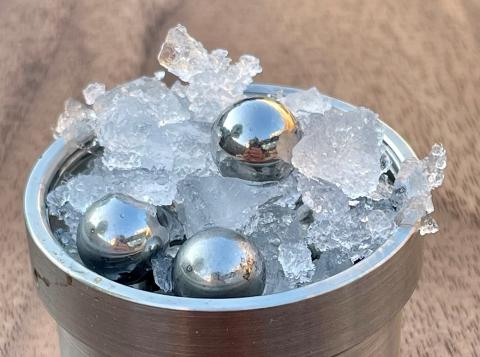
Using a device that might be described as a super-duper cocktail shaker, scientists have fashioned a previously unknown form of ice - one that might exist on our solar system's icy moons - in research that sheds light on water's behavior under extreme conditions.
The researchers said they employed a process called ball milling to vigorously shake ordinary ice together with steel balls in a container cooled to minus-328 degrees Fahrenheit (minus-200 degrees Celsius). This yielded what they called "medium-density amorphous ice," or MDA, which looked like a fine white powder.
Ordinary ice is crystalline in nature, with water molecules - two hydrogen atoms and one oxygen atom, or H2O - arranged in a regular pattern. Amorphous ice's water molecules are in a disorganized form resembling a liquid.
"Ice is frozen water and contains H2O molecules. H2O is a highly versatile molecular building block that can form many different structures depending on temperature and pressure," said University College London professor of physical and materials chemistry Christoph Salzmann, senior author of the research published this week in the journal Science.
"Under pressure, the molecules pack more efficiently, which is why there are many different forms of ice," Salzmann added.
Virtually all ice on Earth exists in its familiar crystalline form - think of the ice cubes in your lemonade. But amorphous ice is by far the most common form of water in space. Scientists have identified 20 different forms of crystalline ice and three forms of amorphous ice - one low density (discovered in the 1930s), one high density (discovered in the 1980s) and the new one in between.
Amorphous ice on Earth may be confined to the atmosphere's frigid upper reaches.
"Almost all ice in the universe is amorphous and in a form called low-density amorphous ice," Salzmann said. "This forms when water condenses onto dust grains in space. Comets are amorphous ice as well. Liquid water requires very special conditions such as on Earth. But there is also evidence for subsurface oceans within some of the solar system's ice moons."
Ball milling is used in industries to grind or blend materials. The researchers used the technique to make about 3 ounces (8 grams) of the new ice, keeping some of it in cold storage.
The question is where this form of ice might exist in nature. The researchers hypothesize that the type of forces they brought to bear on ordinary ice in the laboratory might exist on ice moons like Jupiter's Europa or Saturn's Enceladus.
"We made MDA ice for the first time. So the samples of it in our lab must be the only ones on Earth," Salzmann said.
"We suspect it may exist in some of the ice moons of the solar system. The ball milling induces shear forces within the ice crystals as they collide with the steel balls. In the ice moons, tidal forces from the gas giants (Jupiter and Saturn) are at play and we expect them to induce similar shear forces in the moons' ice shells as during the ball milling," Salzmann added.
The research may facilitate a better understanding of water, a chemical central to life.
"The fact that this new form of ice has a density similar to that of liquid water - and so may be the good model for understanding water without the motion of the liquid - is probably the most important aspect of this discovery," said University of Cambridge chemistry professor and study co-author Angelos Michaelides.
"Since MDA is also a disordered state like liquid water, the question arises if it actually is liquid water but at low temperatures," Salzmann said. "Building on this, MDA provides an opportunity to perhaps finally understand liquid water and its many anomalies."












